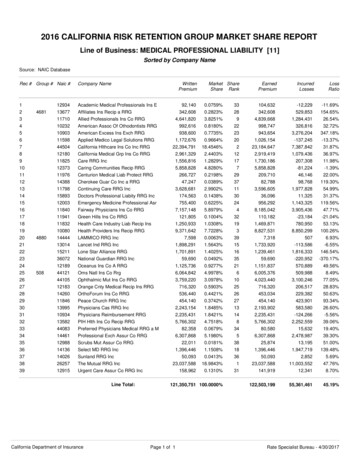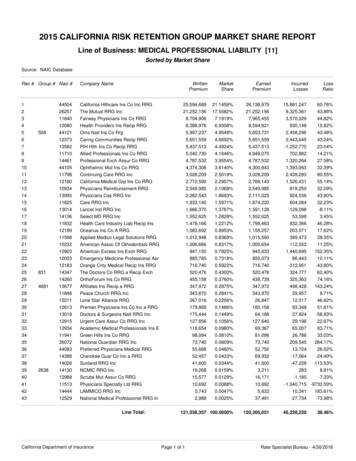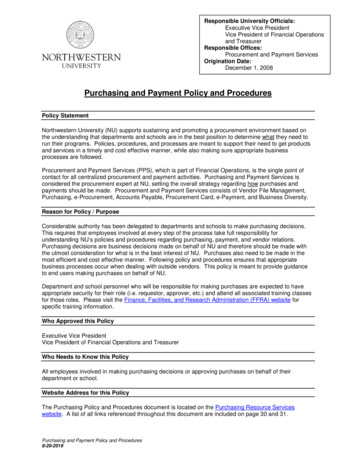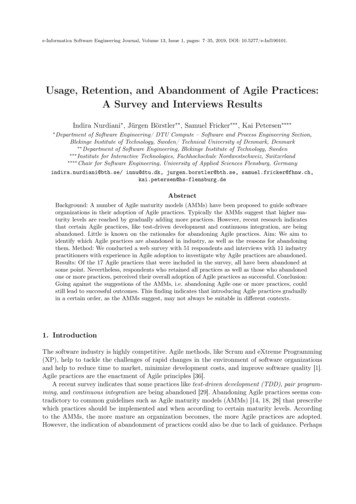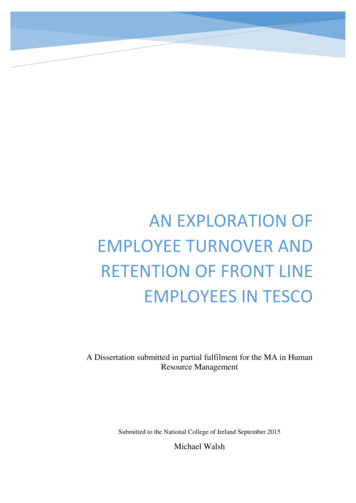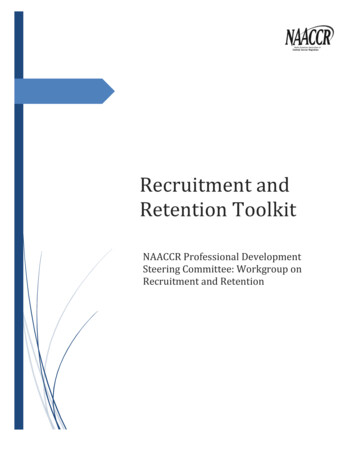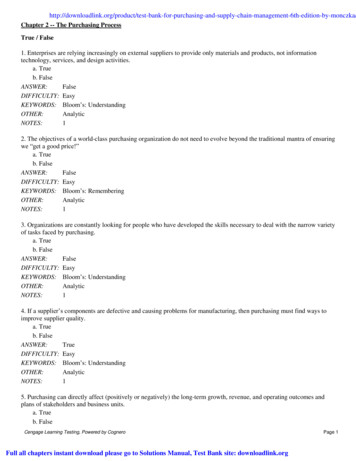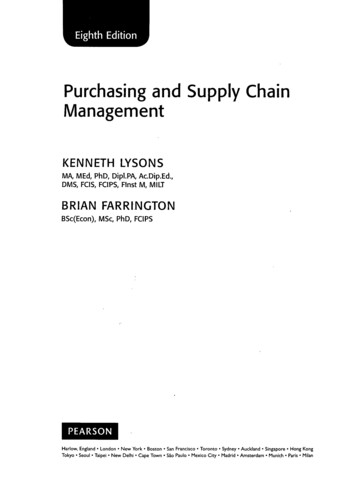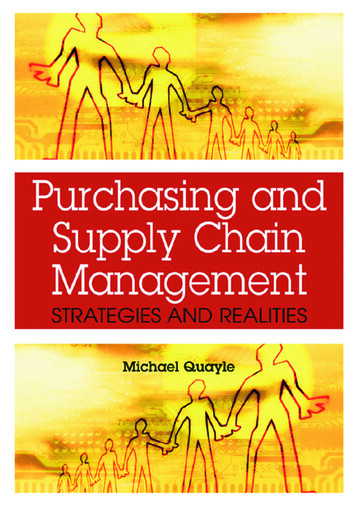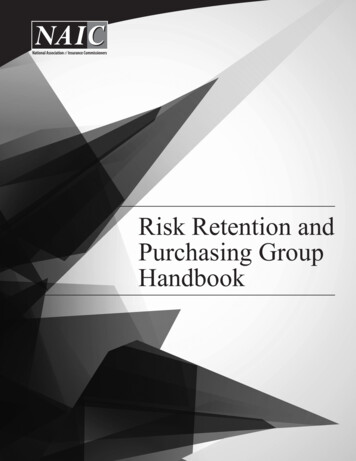
Transcription
Risk Retention andPurchasing GroupHandbook
NAICRisk Retention andPurchasing Group Handbook2020
The NAIC is the authoritative source for insurance industry information. Our expert solutions support the effortsof regulators, insurers and researchers by providing detailed and comprehensive insurance information. TheNAIC offers a wide range of publications in the following categories:Accounting & ReportingInformation about statutory accounting principles and theprocedures necessary for filing financial annual statementsand conducting risk-based capital calculations.Special StudiesStudies, reports, handbooks and regulatory researchconducted by NAIC members on a variety of insurancerelated topics.Consumer InformationImportant answers to common questions about auto,home, health and life insurance — as well as buyer’sguides on annuities, long-term care insurance andMedicare supplement plans.Statistical ReportsValuable and in-demand insurance industry-wide statisticaldata for various lines of business, including auto, home,health and life insurance.Financial RegulationUseful handbooks, compliance guides and reports onfinancial analysis, company licensing, state auditrequirements and receiverships.LegalComprehensive collection of NAIC model laws, regulationsand guidelines; state laws on insurance topics; and otherregulatory guidance on antifraud and consumer privacy.Market RegulationRegulatory and industry guidance on market-relatedissues, including antifraud, product filing requirements,producer licensing and market analysis.Supplementary ProductsGuidance manuals, handbooks, surveys and researchon a wide variety of issues.Capital Markets & Investment AnalysisInformation regarding portfolio values and procedures forcomplying with NAIC reporting requirements.White PapersRelevant studies, guidance and NAIC policy positions ona variety of insurance topics.For more information about NAICpublications, view our online catalog at:NAIC ActivitiesNAIC member directories, in-depth reporting of stateregulatory activities and official historical records ofNAIC national meetings and other activities.http://store.naic.org 201 , 2020 National Association of Insurance Commissioners. All rights reserved.Printed in the United States of AmericaNo part of this book may be reproduced, stored in a retrieval system, or transmitted in any form or by any means, electronic ormechanical, including photocopying, recording, or any storage or retrieval system, without written permission from the NAIC.NAIC Executive Office444 North Capitol Street, NWSuite 700Washington, DC 20001202.471.3990NAIC Central Office1100 Walnut StreetSuite 1500Kansas City, MO 64106816.842.3600NAIC Capital Markets& Investment Analysis OfficeOne New York Plaza, Suite 4210New York, NY 10004212.398.9000
NAICRISK RETENTION AND PURCHASING GROUP HANDBOOKTABLE OF CONTENTSSECTION I. PURPOSE OF THE HANDBOOK AND BACKGROUND OF THE LIABILITYRISK RETENTION ACT OF 1986 (LRRA)A.PURPOSE .I-1B.BACKGROUND .I-1SECTION II. REGULATION OF RISK RETENTION GROUPSA.NOTICE AND REGISTRATION . II-11.NOTICE . II-1(a)(b)(c)2.REGISTRATION - SERVICE OF PROCESS . II-7(a)(b)B.RISK RETENTION GROUPS . II-1(i)Domicilliary State . II-1(ii)Non-Domicilliary State. II-3PURCHASING GROUPS . II-4CHALLENGES TO NON-DOMICILLIARY STATES’REQUIREMENTS CASE LAW . II-5RISK RETENTION GROUPS . II-7PURCHASING GROUPS . II-83.NOTICE AND REGISTRATION FORMS . II-84.REGISTRATION AND OTHER FEES . II-8FINANCIAL CONDITION . II-91.2.RISK RETENTION GROUPS . II-9PURCHASING GROUP INSURERS . II-10C.AGENT/BROKER LICENSING . II-10D.APPLICATION OF STATE FINANCIAL RESPONSIBILITY LAWS . II-101.FINANCIAL RESPONSIBILITY REQUIREMENTS . II-102.CASE LAW AND ADMINISTRATIVE RULINGS . II-12(a)(b)(c)Charter Risk Retention Group v. ROLKA. II-12Mears Transportation Group v. State of Florida . II-13American Inter Fidelity Exchange, a Risk RetentionGroup v. Dawson . II-13 1991-2020 National Association of Insurance CommissionersJune 2020
(d)(e)(f)(g)Garage Services and Equipment Dealers LiabilityAssociation of America, Inc. v. Holmes . II-14Yellow Cab Cooperative, Inc., before the California PublicUtilities Commission. II-15Ophthalmic Mutual Insurance Company(a Risk Retention Group) v. Musser. II-15National Warranty Insurance Company,RRG v. Greenfield. II-16E.LIABILITY INSURANCE UNDER THE LRRA . II-16F.PROHIBITED POLICY COVERAGE. II-20SECTION III. REGULATION OF RISK RETENTION GROUPSA.GENERAL CONCEPTS . III-1B.CHARTERING STANDARDS . III-11.2.3.MANAGEMENT EXPERTISE . III-1REINSURANCE ARRANGEMENTS. III-2ABILITY TO PROVIDE SERVICE . III-2C.SOLVENCY REGULATION . III-2D.RATE REGULATION . III-4E.POLICY FORM REGULATION . III-4F.MARKETING . III-4G.RISK RETENTION GROUP AS REINSURER . III-5H.OTHER ISSUES . III-61.2.3.4.5.GUARANTY FUNDS . III-6RESIDUAL MARKET MECHANISMS . III-6PREMIUM TAXES . III-6DISCRIMINATION AGAINST RRGs . III-6NONADMITTED & REINSURANCE REFORM ACT OF2010 (NRRA). III-7SECTION IV. PURCHASING GROUP AND PURCHASING GROUP INSURER ISSUESA.INTRODUCTION . IV-1B.PURCHASING GROUP EXEMPTIONS FROM STATE LAWS . IV-1C.PURCHASING GROUP’S INSURER REQUIREMENTS . IV-2D.APPLICATION OF EXCESS AND SURPLUS LINESLAWS TO PURCHASING GROUP INSURERS . IV-3E.PURCHASING GROUPS’ INSURER POLICY FORMS AND RATES. IV-3 1991-2020 National Association of Insurance CommissionersJune 2020
F.OTHER ISSUES . IV-31.2.3.G.LICENSING OF AGENTS OR BROKERS FORPURCHASING GROUPS . IV-4JURISDICTIONAL ISSUE . IV-4HOMOGENEITY REQUIREMENT OF PURCHASING GROUPS . IV-4PREMIUM TAXES . IV-4SECTION V. NAIC AND STATE ACTIVITY RELATED TO RISK RETENTION ISSUESAPPENDICESAppendix AAppendix BAppendix CAppendix DAppendix EAppendix FAppendix GAppendix HAppendix ILiability Risk Retention Act of 1986NAIC Model Risk Retention ActState Insurance Department Risk Retention Group and Purchasing Group ContactPersonsNAIC Uniform Risk Retention Group Registration FormNAIC Uniform Purchasing Group Registration FormsSurvey of State Laws Relating to Risk Retention GroupsStatement of Voluntary DissolutionReinsurance Guidelines for Risk Retention Groups Licensed as Captive InsurersRisk Retention Group Notice Language 1991-2020 National Association of Insurance CommissionersJune 2020
SECTION IPURPOSE OF THE HANDBOOK AND BACKGROUND OF THELIABILITY RISK RETENTION ACT OF 1986 (LRRA)A.PURPOSEThe purpose of the Risk Retention and Purchasing Group Handbook (Handbook) is to explore insome detail the provisions and requirements of the Liability Risk Retention Act of 1986 15U.S.C. §3901 et seq. (LRRA) (Appendix A) and the NAIC Model Risk Retention Act (ModelAct) (Appendix B), and to discuss issues that have arisen or can be expected to arise under theLRRA. The question of which aspects of state laws have been preempted by the LRRA andwhich have not is the overall issue that has given rise to many of the other issues. The Handbookwill attempt to explain the various approaches that the states have taken in dealing with theseissues.The NAIC, in this Handbook, does not take a position as to the ultimate legality or utility ofdifferent state approaches to interpretation of the LRRA or their regulation of risk retentionactivities, but attempts to objectively discuss the issues and the ramifications of the differentapproaches in order to allow the regulator to choose intelligently among various alternatives. Theguidance offered in this Handbook is advisory only and is not intended to prescribe mandatoryregulatory procedures. The guidance also is not intended to be all inclusive; rather, it suggestspossible approaches and concepts in order to assist regulators in arriving at a workable approachto dealing with the operations of the risk retention industry in a manner consistent with theLRRA.The Handbook also includes, as appendices, background information and materials, as well asuniform registration forms (Appendices D and E) that the NAIC encourages regulators to utilize.The process of refining the standard forms first adopted by the NAIC in December 1989 andamended in June 1991 continues. The states will be furnished with any modified versions of thesestandard forms as they are adopted by the NAIC.This Handbook will be revised as necessary to incorporate new developments and to provideadditional guidance and information. The Risk Retention Working Group, of the Property andCasualty Insurance (C) Committee, is charged with the responsibility of considering andrecommending to the members of the NAIC revisions to this Handbook.B.BACKGROUNDThe federal LRRA, which was enacted by Congress in 1986, amended and expanded the ProductLiability Risk Retention Act of 1981. The purpose of the LRRA is to increase the availability ofcommercial liability insurance which became severely restricted in the market crisis of the mid1980s. (As used in this Handbook, “commercial liability” means exposures due to business (profitor nonprofit), trade, product, services (including professional services), premises, or operations. Italso includes exposures of state and local governments, their agencies, or political subdivisions.However, it excludes exposures arising from personal, family, or household responsibilities oractivities and an employer’s liability as to its employees, other than under the Federal Employers’Liability Act, 45 U.S.C. § 51 et seq. See U.S.C. § 3901(a)(2) and (3)). The LRRA attempts toaccomplish its purpose by two mechanisms: (1) the Risk Retention Group (RRG) and (2) thePurchasing Group (PG).An RRG is a risk-bearing entity that must be chartered and licensed as an insurance company inone state. The LRRA requires that the primary purpose of the group be to assume and spread the 1991-2020 National Association of Insurance CommissionersI-1
commercial liability risk of its members. Once the group has obtained a license, it may operate inall states without the necessity of a license and is regulated almost exclusively by the domiciliarycommissioner. Non-domiciliary commissioners may require RRGs to comply with the followingstate laws or requirements: Unfair claim settlement practices laws;Laws requiring the payment, on a nondiscriminatory basis, of applicable premiumand other taxes (See Section 3902(a)(1)(B) of the LRRA);Laws requiring participation in a residual market mechanism for liability insurance(See Section 3902(a)(1)(C) of the LRRA);The RRG must register with and designate the insurance commissioner as its agentfor the purpose of receiving service of legal documents or process;Laws regarding deceptive, false or fraudulent acts or practices (See Section3902(a)(1)(G) of the LRRA);Laws requiring RRGs to provide a notice specified in Section 3902(a)(1)(I) of theLRRA cautioning that the policy is written by an RRG and as such may not besubject to all state insurance laws and that guaranty fund protection does not apply.Further, non-domiciliary commissioners are granted authority to monitor the financial solvency ofRRGs and to examine RRGs under certain circumstances. The non-domiciliary commissionerscan: Require the RRG to submit to an examination to determine the RRG’s financialcondition if the domiciliary commissioner has not begun or has refused to initiate anexamination of the RRG. The examination shall be coordinated with the domiciliarycommissioner to avoid unjustified duplication and unjustified repetition. Section3902(a)(1)(E) LRRA.Require the RRG to comply with a lawful order issued in a delinquency proceeding ifthere has been a finding of financial impairment. Section 3902(a)(1)(F)(i) LRRA.Require the RRG to comply with a lawful order issued in a voluntary dissolutionproceeding. See 3902(a)(1)(F)(ii) LRRA.Require the RRG to comply with an injunction issued by a court of competentjurisdiction alleging the RRG is in hazardous financial condition or is financiallyimpaired. Section 3902(a)(1)(H) LRRA.The LRRA requires that the RRG be owned by its insureds and requires the insureds to havesimilar or related liability exposure. The only type of coverage an RRG is permitted to write iscommercial liability insurance for its members and reinsurance with respect to the liability of anyother risk retention group (or any members of another risk retention group) which is engaged inbusinesses or activities so that the group or member meets the requirement for membership in therisk retention group which provides the reinsurance.A PG may purchase only commercial liability insurance for its members. The members of a PGmust share a commonality of purpose and risk. The LRRA requires a PG to be “domiciled” in onestate, but also requires that the insurer providing coverage to the group must be an admittedinsurer, an eligible surplus lines insurer, or a risk retention group registered or operating in thestate where the PG is “located.”With regard to preemption of state laws, the approach taken in the LRRA in connection withRRGs is different than the approach taken in connection with PGs. Under Section 3902 of theLRRA, with the exception of the domiciliary state, RRGs are exempt from all state laws, rules,regulations, or orders that would make unlawful, or would regulate, directly or indirectly, theoperation of an RRG, except as provided in the LRRA. The domiciliary state regulates theformation and operation of the RRG. As mentioned previously, any other state may impose those 1991-2020 National Association of Insurance CommissionersI-2
certain requirements upon RRGs provided by the LRRA, including compliance with unfair claimsettlement practices laws, payment of taxes, limited financial reporting, and registrationrequirements. Financial examinations of an RRG initiated by other states are prohibited, unlessthe domiciliary commissioner has failed or refused to examine the group, but any suchexamination should be coordinated to avoid unjustified duplication and repetition.In contrast, Section 3903 of the LRRA does not contain a similar broad exemption from statelaws for PG mechanisms but, rather, exempts them only from specified state laws, rules andregulations. All state laws not specifically preempted regarding PG and PG insurers remain intact.State laws preempted are primarily prohibitions and limitations in regard to the purchase of groupliability coverage, e.g., fictitious group statutes. Countersignature requirements also arepreempted. Controversy has arisen over the permitted authority of the nondomiciliarycommissioner. Regulators continue to have authority over insurers of purchasing groups pursuantto applicable state law.To date, several federal courts have interpreted the authority of states over PGs and their insurers,ruling that the preemptions of state law contained in the LRRA in regard to PGs are narrow.These cases are discussed in detail in Section IV of this Handbook.State insurance regulators seek to ensure, to the extent permitted by the LRRA, that the riskretention industry operates in a manner which is beneficial, not only to those who obtain theircommercial liability insurance in this alternate insurance market, but also to those third-partyclaimants. One aspect of concern is with financial failures which can affect these risk retentionmechanisms just as they affect the conventional insurance market, but may prove more likely inthe absence or attenuation of regulation. As emphasized in the report of the U.S. House ofRepresentatives Subcommittee on Oversight and Examinations of the Committee on Energy andCommerce, entitled Failed Promises (the Dingell Report), state regulators must be ever vigilant infinancial solvency regulation. RRGs and PG insurers are no exception. Since the LRRA wasenacted in 1986, RRGs and insurers that write coverage for PGs have experienced their share offinancial failures.As with all insurance company insolvencies, the causes leading to the financial failures vary.Even in the best regulatory environment insolvencies cannot be totally prevented. The regulatoryoversight of the financial solvency of an insurer is generally the responsibility of the domiciliarystate, but that oversight is enhanced by the ability of any state to examine a nondomiciliaryadmitted insurer. However, given the long-tail coverage that many risk retention mechanismsprovide and the LRRA’s preemption of nondomiciliary state laws enacted to preserve solvency,state regulators are concerned that a disproportionate number of financial difficulties involvinginsurers operating under the LRRA may occur. RRG failures can affect residents of states where,if not for the LRRA, the RRGs could not legally write business. 1991-2020 National Association of Insurance CommissionersI-3
SECTION IIREGULATION OFRISK RETENTION GROUPS AND PURCHASING GROUPSA.NOTICE AND REGISTRATION1.NOTICEThe LRRA requires that RRGs submit notice to the insurance commissioner of eachnondomiciliary state in which it intends to do business, b
commercial liability insurance which becameseverely restricted in the market crisis of the mid - 1980s. (As used in this Handbook, “commercial liability” means exposures due to business (profit or nonprofit), trade, product, services (including professional services), premises, or operations. It
